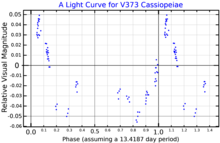V373 Cas is a binary star system in the northern constellation Cassiopeia. It is a suspected eclipsing binary with an apparent visual magnitude that decreases from a baseline of 6.03 down to 6.13.[3] The system is located at a distance of approximately 6,200 light years from the Sun, but is drifting closer with a radial velocity of around −25.5 km/s.[4] It is faintly visible to the naked eye under very good observing conditions.

The binary nature of this system was announced in 1912 by Walter S. Adams.[9] It is a double-lined spectroscopic binary with an orbital period of 13.4 days and an eccentricity of 0.13.[5] The system was found to be variable in 1958 by C. Roger Lynds, and the variability cycle was shown to be related to the orbital period.[9] It has been described as a heartbeat star rather than an eclipsing system. This is a type of pulsating star where the pulsations are induced by the tidal attraction of a close companion.[10]
V373 Cas is composed of two hot blue-white giant stars that have exhausted their core hydrogen and expanded off the main sequence. Lyubimkov and colleagues analysed spectral and radial velocity to calculate that the stars were ~19 and ~15 times as massive as the Sun and the age of the system is around 7-8 million years old.[6] The primary component is the more evolved and now comes close to filling its Roche lobe when it is at periastron.[11]
References
- ^ a b c d e Brown, A. G. A.; et al. (Gaia collaboration) (August 2018). "Gaia Data Release 2: Summary of the contents and survey properties". Astronomy & Astrophysics. 616. A1. arXiv:1804.09365. Bibcode:2018A&A...616A...1G. doi:10.1051/0004-6361/201833051. Gaia DR2 record for this source at VizieR.
- ^ a b c Anderson, E.; Francis, Ch. (2012). "XHIP: An extended hipparcos compilation". Astronomy Letters. 38 (5): 331. arXiv:1108.4971. Bibcode:2012AstL...38..331A. doi:10.1134/S1063773712050015. S2CID 119257644.
- ^ a b Samus, N. N.; et al. (2017). "General Catalogue of Variable Stars". Astronomy Reports. 5.1. 61 (1): 80–88. Bibcode:2017ARep...61...80S. doi:10.1134/S1063772917010085. S2CID 125853869.
- ^ a b Wilson, R. E. (1953). "General Catalogue of Stellar Radial Velocities". Carnegie Institute Washington D.C. Publication. Bibcode:1953GCRV..C......0W.
- ^ a b Hill, G.; Fisher, W. A. (January 1987). "Studies of early-type variable stars. IV. The orbit and physical dimensions for V373 Cas". Astronomy and Astrophysics. 171: 123–130. Bibcode:1987A&A...171..123H.
- ^ a b Lyubimkov, L. S.; et al. (1998). "The binary system V373 Cas: orbital elements, parameters of the components, and helium abundance". Astronomy Reports. 42 (3): 312–321. Bibcode:1998ARep...42..312L.
- ^ "V373 Cas". SIMBAD. Centre de données astronomiques de Strasbourg. Retrieved 2020-11-19.
- ^ Lynds, C. R. (September 1959). "The Light-Variation of HD 224151". Astrophysical Journal. 130: 599–602. Bibcode:1959ApJ...130..599L. doi:10.1086/146748.
- ^ a b Lynds, C. R. (September 1959). "The Light-Variation of HD 224151". Astrophysical Journal. 130: 599. Bibcode:1959ApJ...130..599L. doi:10.1086/146748.
- ^ "V0373 Cas". Retrieved 2020-11-20.
- ^ Karami, K.; Mohebi, R. (December 2009). "Velocity curve studies of spectroscopic binary stars V380 Cygni, V401 Cyg, V523 Cas, V373 Cas and V2388 Oph". Journal of Astrophysics and Astronomy. 30 (3–4): 153–163. Bibcode:2009JApA...30..153K. doi:10.1007/s12036-009-0010-0. S2CID 122334785.












